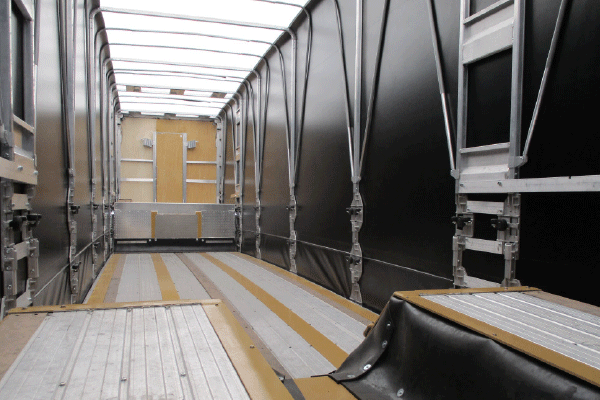- Conestoga trailer definition and explanation
- Different types of Conestoga trailers
- How to know if a Conestoga is right for your freight
As a shipper, it goes without saying that you’re always looking for ways to optimize both your supply chain and your budget.
At the heart of all your carrier relationships is the desire to move freight more efficiently, safely, and with less impact on your bottom line. It turns out that the seemingly simple act of switching to a different trailer type can actually make a major difference.
One such trailer type is the Conestoga trailer, a neatly-packaged, versatile option for hauling freight. Conestogas offer more protection from the elements than the average flatbed trailer but maintain the ease of loading and unloading open-deck freight.
Over our decades in business, Anderson Trucking Service (ATS) has seen firsthand how useful Conestoga trailers can be for shippers. In the right circumstances, these specialized trailers can bring a lot to the table.
To help you better understand your freight transportation options (and ultimately choose the one that's best for your needs), let's dive into the definition of a Conestoga trailer and the nuances of its many variations.
What is a Conestoga Trailer?
Conestoga trailers are specialized trailers with a flatbed frame that can haul a maximum of 44,000 pounds. Their defining feature is a retractable tarp-on-frame system.
Named for the horse-drawn Conestoga wagons used in 19th-century America, Conestoga trailers were developed with security, versatility, and protection from the elements in mind.
A Conestoga’s tarping system spans the length of its deck and has several key functions:
- Unlike traditional open-deck trailers such as the standard flatbed, a Conestoga trailer does not require manual tarping to protect commodities in transport.
- A Conestoga’s tarp curtain can be fully retracted to allow for the side-loading and unloading of freight.
- When necessary, the built-in tarp of a Conestoga easily and effectively conceals identifying details of the cargo within.
For the supply chains that depend on Conestogas, these unique features offer a compelling alternative to classic flatbed or dry van trailers.
Related: What is a Curtainside Trailer? [Definition, Pros and Cons of Using One]
What Are The Different Types of Conestoga Trailers?
The most common types of Conestoga trailers are Conestoga flatbed trailers, step-deck Conestogas, and double-drop Conestogas.
All three types of Conestogas offer its trademark tarping system; the core differences are their maximum dimensions.

Below, we’ll break down these Conestoga types and provide resources to help you understand each trailer’s capabilities at a glance.
It’s important to note that the specifications of each trailer will vary slightly from one to the next. Always consult your provider to find out the measurements and limits for your specific trailer.
Conestoga Flatbed Trailers
The most common kind of Conestoga is the flatbed Conestoga. Used to transport many of the same open-deck commodities as the traditional flatbed, Conestoga flatbed trailers are offered in 48- and 53-foot versions.
Although the dimensions of these trailers vary slightly from one to the next, here are some general guidelines for your reference.
Flatbed Conestoga Dimensions
48’0″L x 8’4″W x 8’0″H (48-foot)
53’0″L x 8’4″W x 8’0″H (53-foot)
- Flatbed Conestoga Maximum Width: 8 feet, 4 inches (100")
- Flatbed Conestoga Maximum Height: 8 feet (96")
- Flatbed Conestoga Length Range: 48 and 53 feet
- Flatbed Conestoga Weight Capacity: 44,000 pounds
Step-Deck Conestoga
Step-deck Conestogas are used to move commodities that require height capacity beyond what’s offered by flatbed Conestogas (96 inches).
As such, step-deck Conestogas are used to transport taller commodities like CNC machinery, robotics, helicopters, and other large freight where in-transit protection is a concern.
Here are the dimensions of the step-deck Conestoga for both its 48- and 53-foot versions.
48-Foot Step-Deck Conestoga Dimensions
10’0″L x 8’4″W x 8’H (upper deck)
38’0″L x 8’4″W x 9’8″H (lower deck)
- Upper Deck Maximum Height: 8 feet (96")
- Upper Deck Length: 10 feet (120")
- Lower Deck Maximum Height: 9 feet, 8 inches (116")
- Lower Deck Length: 38 feet
- Overall Width Capacity: 8 feet, 4 inches (100")
- Weight Capacity: 41,000 pounds
53-Foot Step-Deck Conestoga Dimensions
10’0″L x 8’4″W x 8’H (upper deck)
43’0″L x 8’4″W x 9’8″H (lower deck)
- Upper Deck Maximum Height: 8 feet (96")
- Upper Deck Length: 10 feet (120")
- Lower Deck Maximum Height: 9 feet, 8 inches (116")
- Lower Deck Length: 43 feet
- Overall Width Capacity: 8 feet, 4 inches (100")
- Weight Capacity: 41,000 pounds
Double Drop Conestoga
Conestoga trailers are also offered in a double drop version to accommodate freight weighing less than 36,000 pounds and measuring above 9 feet, 8 inches at their tallest point.
That means that, compared to the other Conestoga types, a double drop can haul less weight but more height.
Double drop Conestogas aren’t nearly as common as their flatbed or step-deck counterparts, but that doesn’t mean they aren’t worth seeking out under the right circumstances.
For companies that need to move particularly tall freight (like certain pieces of equipment and machinery) while still protecting it from the elements, a Conestoga can be a great fit.
Here are the typical dimensions of the standard 48-foot double drop Conestoga.
Double Drop Conestoga Dimensions
9’0″L x 8’4″W x 8’H (front deck)
30’0″L x 8’4″W x 11’7″H (well space)
9’0”L x 8’4”W x 9'6"H (rear deck)
- Front Deck Length: 9 feet (108")
- Front Deck Maximum Height: 8 feet (96")
- Lower Deck Length: 26 to 30 feet
- Lower Deck Maximum Height: 11 feet, 7 inches (139")
- Rear Deck Length: 9 feet ( 108")
- Rear Deck Maximum Height: 9 feet, 6 inches (114")
- Weight Capacity: 35,000 pounds
How to Know If a Conestoga is Right for Your Freight
A Conestoga trailer may be right for your freight if you’re shipping cargo that:
- Requires side loading and unloading
- Is at risk of being damaged by traditional tarping
- Needs to be protected from the elements
- Weighs about 44,000 pounds or less
- Is less than 53 feet long
- Is less than 8 feet, 4 inches wide
- Is less than 10 feet tall
When Conestogas are used appropriately, they can offer a convenient solution that checks many boxes for shippers.
However, a Conestoga may not be the right fit for your freight if you’re shipping a commodity that:
- Weighs more than 44,000 pounds
- Is greater than 53 feet long
- Is greater than 8 feet, 4 inches wide
- Is greater than 10 feet tall
You may benefit more from looking beyond Conestogas at a different trailer type better suited to hauling cargo with larger dimensions.
What’s more, if your freight can handle the relative stress of traditional tarping, it may be more budget-friendly for you to choose a standard flatbed trailer — particularly if you are shipping from a market with a limited supply of Conestogas.
As Conestogas are considered a specialized trailer type, they aren’t as common, and are therefore more costly for shippers to secure capacity.
Ultimately, only you and your transportation provider can decide which trailer type is right for your freight. We recommend talking to your provider about the trailer options available to you and asking for their insight as to which will deliver the best value for your specific use case.

Learn More About the Most Common Trailer Types
Conestogas are a versatile and convenient option for many shippers. The different types of trailers under the Conestoga umbrella provide additional diversity to accommodate a variety of freight types, weights, and dimensions
Between flatbed, step-deck, and double drop Conestogas, there are Conestoga trailers to fit a wide variety of shipping needs. If your freight fits within its dimensional limits, it could be exactly the creative solution you’ve been looking for!
We’ve already encouraged you to ask your transportation provider for their recommendation on the right trailer type for your freight, but it’s important for shippers to do their own research, too.
Check out our article on The 11 Most Common Trailer Types Used in the Trucking Industry in 2025 to get a comprehensive overview of the trailer types you’re likely to encounter throughout your years in the industry.
By developing a strong baseline knowledge of the most common trailer types and their best uses, you can feel confident that you’re making informed decisions for your business.
This knowledge can also help you protect yourself and your business against dishonest providers who may mislead you about the most cost-effective or appropriate trailer for your needs.




